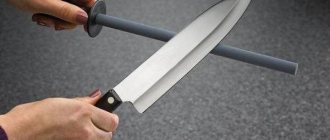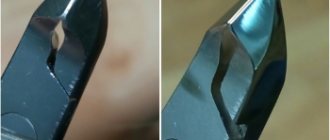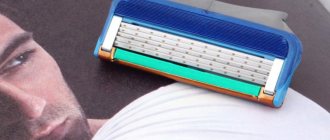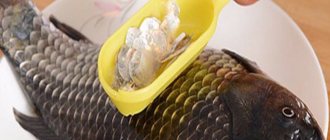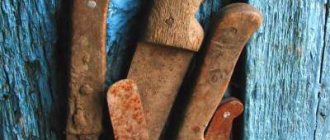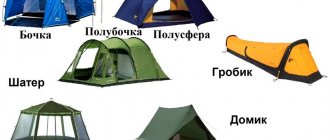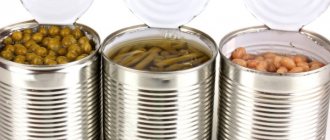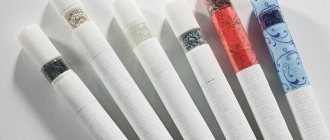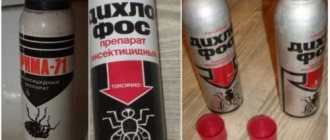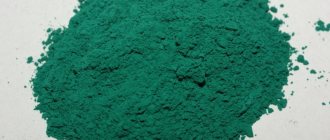Knife device
Maintaining the correct sharpening angle is impossible without knowing the design of the knife blade. Typically it consists of the following parts:
- cutting edge - the sharp part of the knife;
- butt - the upper, widest part, which is often pressed down by hand for convenience;
- descent - from the butt to the cutting edge the blade narrows gradually, the lower converging part, located closer to the sharpened part, is called the descent;
- tip - the point at which the butt and blade meet;
- heel - the unsharpened part located near the junction of the blade and the handle.
One of the most important characteristics of a blade is the sharpening angle of the cutting edge. The smaller it is, the less effort you need to make for cutting, that is, the easier the knife enters the plane being cut. However, you should not reduce this parameter too much. After all, at a small angle, the blade becomes fragile and is quite easy to damage.
The lowest degree of sharpening (10°) in straight razors. The largest (40°) – in high-strength hunting and tactical (used in field or extreme conditions) knives. The optimal sharpening angle for kitchen knives is 25-30°.
A universal kitchen knife has medium dimensions and a blade length of 15 cm. A distinctive feature of a chef's knife is its wide 18-25 centimeter blade. The fillet tool, on the contrary, has a narrow, long blade. The Japanese santoku is similar in appearance to a chef's knife, but its tip is rounded and lowered, which allows you to cut any, even the most “capricious”, soft or porous products, for example, bread, with filigree precision. It is also indispensable when chopping vegetables or cutting meat.
The most common blade shape is lens-shaped (razor), with a thick spine and the thinnest cutting part. Light weight and sufficient rigidity make this blade the most convenient.
Finnish knives have a wedge-shaped blade. The wedge of other types of knives may have a smooth transition from the butt to the cutting edge or, on the contrary, pronounced ribs.
Device
Blade shapes
Common Mistakes
So, we found out how to properly sharpen knives by hand. Let's list the common mistakes of inexperienced consumers to summarize. Definitely not worth it:
- Place the stone directly on the table, without a backing.
- Use only one water stone for sharpening.
- Wet the stone only once.
- Sharpen dirty and greasy knives.
- Apply excessive pressure on the knife while sharpening.
- Violate the factory sharpening angle.
- Finish sharpening ahead of time without removing the burrs completely.
Such actions can reduce the efficiency of your work or even lead to damage to the blade.
Did you like the article? Have you read to the end?! Using the promotional code Stone we give a DISCOUNT on your purchase in the cart!
Shapes and sharpening angles
An experienced hunter or fisherman will never take with him a tool with a weak blade made of low-quality or too thin steel. In the kitchen, for slicing or cutting, they often use the first knives that come to hand, without even realizing that they are thereby complicating their work. After all, when using knives of a certain shape, with different sharpening angles, you can get a perfect cut and quickly and accurately cut meat or fish.
Table of standard values
Users are often interested in what angle to sharpen a kitchen knife. This parameter directly depends on the purpose of the tool. Examples of standard values are presented in the table of sharpening angles for kitchen, hunting knives and scissors.
| Knife type | Angle degree |
| Kitchen universal | 30-35 |
| Povarskaya | 20-25 |
| For meat | 25-30 |
| Table for vegetables and meat | 65-70 |
| For steaks and roast beef | 16-25 |
| Cutting | 25-30 |
| Sirloin | 10-15 |
| For cutting frozen fish and meat | 35-45 |
| Myasnitsky | 30-40 |
| For cleaning root vegetables | 20-25 |
| Bread-cutting | 15-22 |
| For vegetables and bread | 10-15 |
| Penman | 20-30 |
| Folding hunting | 40-45 |
| Shoe worker | 30-40 |
| Versatile for heavy duty work | 40-45 |
| Household scissors | 45-65 |
Sharpness directly depends on the inclination of the converging edges. At small angles you can sharpen knives even to razor sharpness. However, when cutting dense materials, such a blade will easily wrinkle. These knives are only suitable for slicing bread and vegetables. Therefore, knives are sharpened depending on the purpose of a particular tool.
An angle of 30-35° for kitchen knives is considered universal. However, it will be problematic to achieve high accuracy and speed of work using such tools. For slicing cooked foods, it is better to use a blade with an angle of 20-25°.
For knives intended for working with frozen foods, it is better to make the slope less, otherwise the thin blade will quickly break. Hunting and fishing knives have the highest degree of sharpening angle. Cutting accuracy is not as important here as increased strength.
Determination methods
How to determine the sharpening angle of any knife? This is not difficult to do. The most common methods:
- By securing the knife in scissors. This is an extremely simple method in which the surface of the blade to be sharpened must be placed between two blades of scissors. Next, the angle between the half-open panels is measured with a protractor. To prevent displacement, the bolt between them should first be tightened well. To obtain an accurate result, scissors with the maximum blade length are selected.
- Using a ruler-square. Initially, measurements are made in the same way as in the previous case, using scissors. Next, you need to circle the result on paper and place a square between the resulting lines.
- Using a board and paraffin. Melted paraffin is applied to the oiled edge of the board. Then a blade is stuck into it. After the wax has hardened and the blade has been removed, take a photo of the result. When the image is enlarged, the angle will be clearly visible and can be measured.
Using a ruler
Scissors
Using a board and paraffin
How to properly sharpen blades made of different steels
Products made from some metals require special processing. Blades made of Damascus or damask steel, which are highly valued by hunters, stand out here.
Damascus steel
To preserve its integrity, sharpening is possible only by hand, since the composition contains hard and soft alloys.
To check the strength of the metal, immediately before sharpening, the sharpness of the edge is determined: the sharper it is, the harder the steel itself.
Another feature of the process is sharpening, which is carried out only along the blade. At the beginning of the work, a fine-grained sharpening stone is used, followed by a transition to “velvet” sandpaper.
Bulat steel
All work is carried out exclusively on a wet block. The process begins with a whetstone with large grains and ends with a small grain. Finishing grinding is carried out on ceramics.
Angle Holding Devices
To ensure that the sharpening angle does not change during operation, the blade must be well secured. There is a huge range of sharpening tools available on the market. The best devices for home use are mechanical sharpening systems with removable stones and the ability to set the angle. The following devices will help maintain the correct sharpening angle of a kitchen knife:
- A stand-holder for stones, on one side of which a certain adjustable slope is provided. Such devices allow you to raise the blade above the surface level and firmly fix it motionless. Since the tool will constantly come into contact with abrasive suspension and moisture, it is better to purchase a stand made of materials that are resistant to corrosion.
- A sharpening machine of the Ruixin Touch Pro type, which is a stand with a clamp (stop) in the form of a plate. The tool is fixed using a bolt with 2 washers, which allows you to set any sharpening angle of the knives as accurately as possible.
Electric sharpeners for home use only have one standard degree of angle (about 30°). Therefore, it is not recommended to use them for knives with a smaller sharpened angle.
Ruixin Touch Pro Steel
Stand holder
Table of standard angle values
For high-quality processing and maintenance of tools, it is necessary to maintain the correct sharpening angle. There will be one for each type of task. Below is a table that can be used to select the desired value for the instrument:
| Knife types | Sharpening angles |
| Dining rooms for serving | 55° — 60° |
| Kitchen household | 30° — 35° |
| Kitchen professional | 25° — 30° |
| Chefs professional | 20° — 25° |
| Cutting for fish | 25° |
| Cutting machines for meat and large fish | 30° |
| Vegetable cutters | 35° |
| Fruit | 10° — 15° |
| Cutting for root vegetables | 22° — 25° |
| Boning machines for meat | 25° — 30° |
| Chopping axes | 25° — 30° |
| Sirloin | 10° — 15° |
| Penknives | 20° — 25° |
| Tourist / hunting, priority is spiciness | 30° — 35° |
| Tourist / hunting, wear resistance is a priority | 40° — 45° |
| Shoe repair | 30° — 40° |
| Shoe cutting machines | 20° — 25° |
| Universal carpentry | 30° — 45° |
| Chopping (machete) | 45° — 60° |
Features of Japanese models
The method of sharpening Japanese kitchen knives differs from European ones. Such tools are given ideal sharpness by a special method in which the blade is processed not on both sides, but only on one side. Thanks to this, the cutting edge becomes as thin as possible. This method is also convenient because the blade can last for a very long time without sharpening. Even with active use, the knife will remain sharp for a long time.
The only drawback is that if handled improperly, the thin blade may move slightly to the side. However, even with a large bend it is quite difficult to damage it. The type of steel used for manufacturing allows you to quickly restore its shape.
The peculiarity of such tools is an expanded blade, especially at the heel, and a lowered butt (the upper part of the blade), providing ease of cutting and a smooth cutting edge. With their help, you can very quickly cut vegetables or meat into perfectly smooth and thin pieces.
Unlike European models, Japanese ones have more compact rounded handles. You no longer have to constantly tilt the tool with its tip down while trying to hold it in your hand. The thin handle leaves enough room for a comfortable grip.
What sharpening angle is optimal for such a tool? In most cases it is 15-18°. But there are also special types of Japanese knives that require sharpening up to 40°. It is better to do this manually using a water stone. A Japanese blade and a machine are incompatible things.
Magnetic models of Japanese instruments do not need to be sharpened. Thanks to the special steel, which easily restores the bonds of the crystal lattice, after some time they sharpen themselves again.
You can even determine the sharpness of the blade visually. If the edge casts glare in the light, this means that there are still unsharpened areas on it.
Caring for a hunting knife
Basic rules for caring for a hunting knife:
- It is necessary to have your knife professionally sharpened regularly to ensure that its edge is always sharp.
- Over time, the blade becomes dull and sometimes rusts. To give it shine, you need to clean it with steel wool, which is soaked in special oil. And to remove rust, its surface must be treated with polishing paste.
- If the knife handle is made of wood, then caring for it requires special care. Due to the possible drying of the wood, it is recommended to keep the blade away from the stove, warm radiators or open sunlight. If the knife handle is made of leather, it can also be treated with special products.
Why does the knife get dull?
Naturally, tools made from high-quality steel do not become dull so quickly. But even the most high-tech metal can wear out. Factors that lead to loss of blade sharpness:
- Inappropriate use: for example, bending metal clips, nails.
- Frequent work with dense materials (bones and tendons).
- Improper storage, in which the blade is constantly in contact with other metal devices. Friction against metals causes the thin edge of the blade to lose its sharpness. Therefore, it is better to store blades on special stands or magnetic holders.
- Cutting on excessively hard surfaces (glass, ceramic, or stone cutting boards). When working, it is better to use a regular wooden cutting board. It is acceptable to use plastic; professional kitchen boards are made from this material.
- Frequent cutting of materials of heterogeneous structure, in which the blade experiences resistance under lateral load.
- Using aggressive chemicals that destroy metal or too hot water when washing.
For ductile carbon steels, the sharpening angle of the knives can be made a little smaller without fear of jamming the edge. If handled correctly, the blade can go a long time without sharpening, if the blade is made of high-quality steel with a high hardness index. If the cutting edge is dull, it needs to be corrected in time, because it is easier to get hurt with a dull knife than with a sharp one.
Blades that cannot be sharpened
Modern models of self-sharpening knives do not require additional processing. Moreover, sharpening will only harm the blade, since its surface is treated with a special layer that will be damaged by friction.
It is not recommended to sharpen knives that have a wavy or saw-toothed cutting edge, since they can be sharpened correctly only with special equipment and with certain skills.
